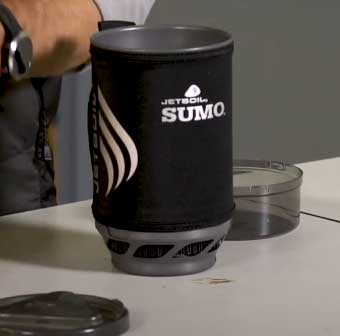Welcome to the ultimate showdown between two campsite culinary champions: the Jetboil Sumo and the MiniMo Stoves. Both pack a punch when it comes to delivering hot meals in the great outdoors, but which one emerges as the ultimate backpacker’s companion?
Let’s dive in and find out.
A Brief Comparison Table
| Features | Jetboil Sumo | Jetboil MiniMo |
| Weight | 16 oz | 14.6 oz |
| Pot Volume | 1.8 liters | 1 liter |
| Boil Time (for 1 liter) | Under 5 minutes | Slightly over 5 minutes |
| Simmer Control | Average | Excellent |
| Stability | High | Moderate |
| Packed Size | Bigger | Compact |
| Price | Slightly Higher | More Affordable |
These differences between the Jetboil Sumo and MiniMo make them cater to different user needs. While the Sumo is perfect for larger meals and rapid boiling, the MiniMo is ideal for solo travelers, simmering meals, and those wanting to keep their backpacks light. Happy camping and cooking!
A Deep Dive into Jetboil Sumo Stove
First up in the ring is the hefty contender, the Jetboil Sumo Stove. This beast, as the name suggests, brings considerable heft and capacity to the table.
However, it’s not just about size; the Jetboil Sumo delivers where it matters most – performance.
- Pros of Jetboil Sumo Stove

One of the biggest pros of the Jetboil Sumo is its unparalleled capacity.
With a 1.8 liter cooking pot, it’s perfect for the solo adventurer who loves a hearty meal, or the pair of travelers sharing a sunset dinner on a peak.
This stove isn’t just about volume though. Its FluxRing technology ensures efficient heating, letting you boil water in under five minutes.
The Jetboil Sumo also boasts a stability that’s hard to beat.
Thanks to its wider burner base, you can stir your culinary creations without the fear of toppling over.
- Cons of Jetboil Sumo Stove
On the flip side, the Sumo’s larger size means it’s not as compact as some other models, such as its rival in this article, the MiniMo. This could be a significant con for ultralight backpackers who count every ounce.
Furthermore, while the Sumo excels at boiling water quickly, it’s not as adept at simmering. Those who relish in campsite gourmet cooking might find this a considerable drawback.
Also Read: Differences Between Jetboil Sumo And Flash Stoves.
A Close Look at Jetboil MiniMo Stove
Now, let’s shift gears and get to know the compact powerhouse, the Jetboil MiniMo Stove. Don’t let the smaller size fool you; this lightweight contender packs in some serious features that make it a worthy adversary to the Sumo.
- Pros of Jetboil MiniMo Stove

The MiniMo’s primary advantage is its portability.
Weighing in at just 14.6 oz, this stove is a dream come true for minimalists and ultralight backpackers.
Its 1-liter pot is perfectly sized for one-person meals, and the entire system is compact enough to fit into your pack without a fuss.
One area where the MiniMo really shines is in its simmer control.
It offers a steady, adjustable flame that can gently simmer your meals to perfection.
Plus, the inclusion of a push-button igniter ensures easy operation.
- Cons of Jetboil MiniMo Stove
The MiniMo’s smaller pot size can be limiting if you’re planning to cook for more than one person. Also, despite its excellent simmer control, it doesn’t boil water quite as quickly as the Sumo.
Key Differences Between Jetboil Sumo and MiniMo Stoves
While the Jetboil Sumo and MiniMo stoves both boast efficient cooking and solid design, a few key differences might sway your decision depending on your unique needs and preferences.
- Size and Weight
The Jetboil Sumo, with its 1.8-liter pot, is bigger and heavier than the MiniMo. If your hiking ethos is ‘the bigger, the better,’ or if you often cook for two, this stove’s larger size might appeal to you.
However, the MiniMo’s more compact design (accompanied by a 1-liter pot) is a godsend for ultralight backpackers or solo travelers.
- Cooking Versatility
If simmering a delicious sauce to perfection is your style, the MiniMo’s superior simmer control makes it a clear winner. It gives you more freedom to play chef even while outdoors.
However, if your primary need is to boil water quickly—for that life-saving coffee or instant noodles—the Sumo’s speedy boiling capabilities take the cake.
- Stability
The Sumo’s wider burner base offers more stability, which can be a great advantage if you’re camping in areas where the ground isn’t always even. The MiniMo, while not unstable, doesn’t quite match up to the Sumo in this department.
- Price
Generally, the Sumo is priced slightly higher than the MiniMo, which is worth considering if you’re on a budget. While both stoves offer excellent value for their price, you’ll need to decide if the Sumo’s larger capacity and stability justify the extra expense.
Also Read: Differences Between Jetboil Stash And MiniMo Cooking Systems.
The Final Verdict
In the heated battle of Jetboil Sumo vs. MiniMo, it’s clear that both stoves have their distinct strengths and weaknesses. The Jetboil Sumo excels in capacity and rapid boiling, while the MiniMo wins points for compactness and excellent simmer control.
Choosing between the two often comes down to your specific needs. If you prioritize cooking larger meals and boiling water quickly, the Sumo could be your best bet.
On the other hand, if you’re an ultralight backpacker who needs a compact, simmer-friendly stove, the MiniMo may be your perfect match.
No matter what you choose, both the Jetboil Sumo and the MiniMo Stoves promise reliable performance, fuel efficiency, and the promise of a hot, delicious meal even in the harshest of outdoor conditions.
Choose wisely, and may your adventures be fueled by memorable meals cooked on the trail.


